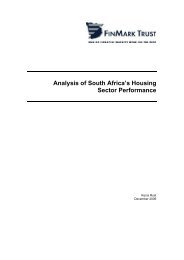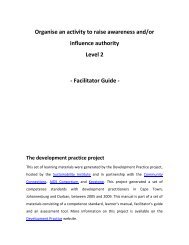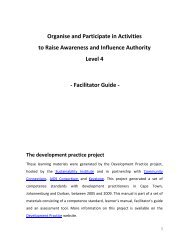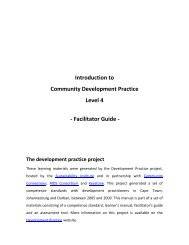the struggle for integrated sustainable settlements.
the struggle for integrated sustainable settlements.
the struggle for integrated sustainable settlements.
You also want an ePaper? Increase the reach of your titles
YUMPU automatically turns print PDFs into web optimized ePapers that Google loves.
Many South African metros and municipalities are facing <strong>the</strong> twin challenge of massively expanding <strong>the</strong><br />
size of <strong>the</strong>ir <strong>for</strong>mal housing stock to meet <strong>the</strong> needs of <strong>the</strong> poor, and a simultaneous increase in demand of<br />
middle class markets. However, cities must begin to recognise and remain within accepted ecological limits<br />
with respect to energy, water, landfi ll space, sewage disposal, food supplies and biodiversity.<br />
The challenge is to imagine a massive housing programme in South Africa which:<br />
• provides safe, quality, well-located housing <strong>for</strong> <strong>the</strong> poor<br />
• complies with densifi cation policies (which may be too moderate)<br />
• utilises a range of new technologies and design features (en<strong>for</strong>ced through bylaws) that massively reduce<br />
<strong>the</strong> average amount of energy, water, materials and use of sinks (landfi ll space, air space <strong>for</strong> pollution,<br />
emissions, etc) that each house needs over its life cycle<br />
• boldly intervenes in <strong>the</strong> agricultural food chain to localise food supplies and thus create markets <strong>for</strong> urban<br />
agriculturalists and peri-urban small-scale farmers.<br />
TECHNOLOGIES AND DESIGN<br />
REQUIRED FOR SUSTAINABLE HOUSING<br />
It is critical that <strong>sustainable</strong> design criterion are followed, and appropriate technologies are used in<br />
<strong>sustainable</strong> settlement roll-outs. Sustainable design criterion should include <strong>the</strong> following 3 :<br />
• Thermally effi cient design<br />
• Sustainable building materials<br />
• Energy effi ciency<br />
• Renewable energy options<br />
• Sustainable water and sanitation systems<br />
• Waste minimisation and recycling<br />
These <strong>sustainable</strong> resource use interventions should be aligned with <strong>the</strong> pro-poor approach in BNG, through<br />
creating a benchmark that excess consumers must aim to achieve via reduction, and under-consumers (due<br />
to poverty/inequality) aim to achieve via access to public goods, subsidies and markets.<br />
In “A Sourcebook of Integrated Ecological Solution,” Janis Birkeland explains that present built environment<br />
confi gurations are <strong>the</strong> result of modern, industrial modes of development, rooted in fossil fuel and non-<br />
page 12<br />
3 Some of <strong>the</strong>se <strong>sustainable</strong> resource use interventions are discussed in more depth in o<strong>the</strong>r chapters and are included here purely to provide a more complete<br />
overview.








